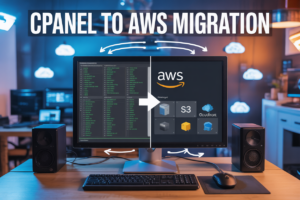Modern web users expect to share specific pages and bookmark deep content within single-page applications. Angular deep linking combined with AWS Amplify routing makes this possible while keeping your cloud-native Angular apps scalable and secure.
This guide is for Angular developers who want to implement robust deep link implementation Angular solutions using cloud infrastructure. You’ll learn how to move beyond basic client-side routing to create production-ready applications that handle direct URL access seamlessly.
We’ll walk through setting up AWS Amplify authentication to secure your deep links, show you how to optimize Angular performance optimization for cloud-deployed routes, and cover AWS Amplify deep links best practices that prevent common pitfalls like 404 errors on page refresh.
By the end, you’ll have a complete cloud routing solutions strategy that works reliably across different devices and browsers, plus the testing tools to keep your Angular URL routing AWS setup running smoothly in production.
Understanding Deep Linking in Angular Applications
What Deep Linking Means for Modern Web Apps
Deep linking in Angular applications allows users to navigate directly to specific pages or components using URLs, bypassing the traditional homepage entry point. Unlike shallow links that only access main pages, Angular deep linking enables bookmarking of complex application states, including filtered views, user dashboards, or multi-step processes. When implemented with AWS Amplify routing, these links maintain their functionality across different environments and deployment stages, ensuring consistent user access patterns.
Benefits of Implementing Deep Links in Angular
Angular deep linking transforms user engagement by enabling direct access to application content through shareable URLs. Users can bookmark specific views, share exact application states with colleagues, and return to previous work sessions without navigating through multiple screens. Search engines can index individual pages, dramatically improving SEO performance and organic discovery. Cloud-native Angular apps with proper deep link implementation see increased user retention rates, as visitors can access relevant content immediately rather than abandoning complex navigation flows.
Common Deep Linking Challenges Without Proper Infrastructure
Traditional Angular applications face significant hurdles when implementing deep links without cloud infrastructure support. Server-side routing conflicts cause 404 errors when users refresh deep-linked pages, breaking the user experience entirely. Manual server configuration becomes complex and error-prone, especially when managing multiple environments. Without proper AWS Amplify authentication integration, protected routes fail to maintain security contexts, forcing users through repeated login cycles. Browser history management becomes unreliable, and social media sharing produces broken links that damage brand credibility.
How Deep Links Improve User Experience and SEO
Deep link implementation in Angular dramatically enhances user experience by reducing friction in content discovery and navigation. Users can share specific application states through URLs, enabling collaborative workflows and seamless handoffs between team members. Search engines crawl and index individual pages, expanding organic reach and improving search rankings for niche content. AWS Amplify’s cloud routing solutions ensure deep links remain functional across different devices and network conditions, while maintaining fast load times through intelligent caching mechanisms that prioritize frequently accessed routes.
Setting Up AWS Amplify for Angular Deep Linking
Installing and Configuring AWS Amplify CLI
Start by installing the AWS Amplify CLI globally using npm install -g @aws-amplify/cli. After installation, configure your AWS credentials by running amplify configure, which opens your browser to set up IAM user permissions. This process creates the necessary access keys for AWS Amplify routing and cloud-native Angular apps deployment. The CLI provides essential tools for managing Angular deep linking infrastructure and seamless integration with AWS services throughout your development workflow.
Initializing Your Angular Project with Amplify
Navigate to your Angular project root directory and run amplify init to bootstrap your cloud-native Angular app with AWS services. Choose your preferred editor, select JavaScript as your framework, and specify your build commands and output directory as dist/your-app-name. The initialization process creates an amplify folder containing your project configuration files. This setup enables deep link implementation Angular patterns while establishing the foundation for AWS Amplify authentication and hosting services integration.
Configuring Amplify Hosting Settings for SPA Routing
Configure your Angular app for Single Page Application routing by creating a redirects file in your public directory. Add the redirect rule /* /index.html 200 to ensure all deep linked routes serve your main application file. Run amplify add hosting to enable AWS Amplify hosting with automatic builds and deployments. This configuration handles Angular URL routing AWS requirements by preventing 404 errors when users access deep links directly, enabling seamless navigation across your cloud routing solutions implementation.
Implementing Cloud-Native Routing Solutions
Configuring Angular Router for Deep Link Support
Setting up Angular deep linking requires careful router configuration to handle both client-side navigation and direct URL access. Configure your Angular Router with proper route definitions and enable HTML5 pushState routing. Set useHash: false in your router module to support clean URLs without hash fragments. Import RouterModule with forRoot() and define routes with parameters and guards. Enable trailingSlash redirection and configure wildcard routes for error handling. This foundation ensures your Angular app responds correctly to deep links while maintaining proper navigation states.
Setting Up Amplify Console Redirects and Rewrites
AWS Amplify Console redirects and rewrites are essential for cloud-native Angular apps to handle deep linking properly. Create an amplify.yml configuration file specifying build settings and redirect rules. Configure single-page application (SPA) rewrites by adding a catchall rule that redirects all requests to index.html with 200 status codes. Set up custom headers for security and caching optimization. Use pattern matching for dynamic routes and implement fallback strategies for 404 errors. These Amplify routing solutions ensure your deployed Angular app serves the correct content for any deep link URL.
| Redirect Type | Pattern | Target | Status |
|---|---|---|---|
| SPA Fallback | /* |
/index.html |
200 |
| API Routes | /api/<*> |
https://api.domain.com/<*> |
200 |
| Asset Redirect | /assets/<*> |
/assets/<*> |
301 |
Managing Route Parameters and Query Strings
Route parameters and query strings in cloud-native Angular apps require careful handling to maintain state across deep links. Use Angular’s ActivatedRoute service to extract parameters and query strings from URLs. Implement proper parameter validation and type conversion for robust routing. Store route state in services or state management solutions like NgRx for complex applications. Handle optional parameters with default values and implement parameter encoding for special characters. Consider URL length limitations and optimize parameter structures for better SEO and user experience.
// Route parameter handling example
constructor(private route: ActivatedRoute) {
this.route.paramMap.subscribe(params => {
const id = params.get('id');
const category = this.route.snapshot.queryParams['category'];
});
}
Handling Dynamic Routes with Amplify Backend Services
Dynamic routes in AWS Amplify leverage backend services for real-time content delivery and authentication. Integrate AWS AppSync for GraphQL APIs that support dynamic route resolution. Use Amplify DataStore for offline-first routing with automatic synchronization. Implement route guards that validate user permissions through AWS Cognito authentication. Configure Lambda functions for server-side route processing and content generation. Set up DynamoDB triggers for dynamic route updates and cache invalidation. These cloud routing solutions provide scalable, secure deep linking that adapts to changing backend data and user contexts.
Optimizing Performance for Deep Linked Routes
Implementing Lazy Loading for Route-Specific Modules
Angular deep linking performance skyrockets when you implement lazy loading for route-specific modules. Instead of bundling everything upfront, lazy loading splits your Angular app into smaller chunks that load only when users navigate to specific deep links. Configure your routing module with loadChildren to dynamically import modules, reducing initial bundle size and improving Time to Interactive metrics. This approach works seamlessly with AWS Amplify’s deployment pipeline, automatically generating optimized chunks during the build process.
Leveraging Amplify’s Global CDN for Faster Load Times
AWS Amplify’s built-in CloudFront CDN dramatically accelerates deep link navigation by caching your Angular assets across 400+ global edge locations. When users access deep-linked routes, static resources load from the nearest edge server rather than your origin. Configure custom cache behaviors for different file types – set longer TTLs for JavaScript bundles and shorter ones for HTML files. Amplify automatically handles cache invalidation during deployments, ensuring users always receive the latest version of your cloud-native Angular apps.
Caching Strategies for Deep Linked Content
Smart caching transforms deep link performance from sluggish to snappy. Implement browser caching with appropriate HTTP headers for static assets, while using service workers to cache dynamic content and API responses. Store frequently accessed data in browser storage to eliminate redundant network requests when users navigate between deep-linked pages. AWS Amplify’s DataStore provides offline-first caching that syncs automatically, perfect for maintaining fast deep link experiences even with poor connectivity. Combine this with Angular’s HTTP interceptors to implement intelligent cache-first strategies.
Security and Authentication with Deep Links
Protecting Private Routes with Amplify Auth
AWS Amplify authentication seamlessly integrates with Angular deep linking to secure private routes. Configure Amplify Auth guards to automatically redirect unauthorized users attempting to access protected deep links. Set up authentication flows that preserve the original deep link destination, allowing users to return to their intended page after successful login. This approach maintains user experience while ensuring Angular deep linking security across your cloud-native Angular apps.
Implementing Route Guards for Secure Deep Links
Angular route guards work hand-in-hand with AWS Amplify authentication to create bulletproof deep link security. Implement CanActivate guards that check user authentication status before allowing access to protected routes. These guards intercept deep link navigation attempts and validate user permissions against your Amplify backend. Configure guards to store the attempted route and redirect users back after authentication, creating a smooth flow for AWS Amplify deep links.
Managing User Sessions Across Deep Link Navigation
Session management becomes critical when users navigate through deep links in your Angular app deployment AWS infrastructure. Amplify Auth automatically handles token refresh and session persistence across different entry points. Configure session storage to maintain authentication state when users bookmark or share deep links. Set appropriate session timeouts and implement automatic re-authentication flows to keep users logged in while navigating through various deep-linked sections of your application.
Handling Authentication State in Shared Links
Shared deep links require special handling to maintain security while providing accessibility. Design your AWS Amplify routing system to detect when users access shared links without valid authentication. Implement smart fallback mechanisms that show appropriate content previews or login prompts for unauthenticated users. Create different link formats for public versus private content, ensuring that sensitive information remains protected while allowing legitimate sharing of public deep links throughout your Angular performance optimization strategy.
Testing and Monitoring Deep Link Implementation
Setting Up Automated Tests for Deep Link Functionality
Automated testing for Angular deep linking requires comprehensive test coverage across multiple scenarios. Start by writing unit tests for your routing components using Jasmine and Karma, testing direct navigation to deep-linked routes. Create end-to-end tests with Cypress or Protractor to simulate real user interactions, including bookmark navigation and external link clicks. Set up tests that verify route guards work correctly with AWS Amplify authentication, checking both authenticated and unauthenticated deep link access. Mock AWS services during testing to ensure consistent results across different environments. Include tests for query parameters, route fragments, and dynamic route segments to catch edge cases before production deployment.
Using Amplify Analytics to Track Deep Link Performance
AWS Amplify Analytics provides powerful insights into your Angular app’s deep link implementation effectiveness. Configure custom events to track deep link usage patterns, measuring which routes users access most frequently and where they drop off. Set up conversion funnels to understand how deep links impact user engagement and business goals. Track performance metrics like page load times for deep-linked routes compared to standard navigation paths. Use Amazon Pinpoint integration to segment users based on their deep link entry points, enabling targeted messaging and personalized experiences. Monitor bounce rates from external deep links to identify potential UX improvements and optimize your cloud-native Angular routing strategy.
Debugging Common Deep Link Issues in Production
Production deep link debugging requires systematic approaches to identify and resolve issues quickly. Common problems include route resolution failures, authentication conflicts, and missing query parameter handling. Use AWS CloudWatch logs to track routing errors and Amplify Console’s debugging tools to monitor client-side issues. Implement proper error boundaries and fallback routes for broken deep links, directing users to meaningful alternative pages. Check for case sensitivity issues in URLs and ensure your Angular app deployment AWS configuration handles trailing slashes consistently. Use browser developer tools to inspect network requests and verify that AWS Amplify authentication tokens properly accompany deep-linked route requests, preventing unauthorized access errors.
Deep linking in Angular apps gets much easier when you embrace AWS Amplify’s cloud-native approach. By setting up proper routing solutions, optimizing performance, and implementing solid security measures, you can create seamless user experiences that work reliably across different environments. The combination of Angular’s routing capabilities with Amplify’s infrastructure gives you the tools to handle complex navigation scenarios without breaking a sweat.
Don’t forget to test your deep links thoroughly and keep an eye on how they perform in production. Start small with a few key routes, then expand as you get comfortable with the setup. Your users will appreciate being able to jump straight to the content they need, and you’ll love how straightforward it is to maintain once everything’s in place.




















